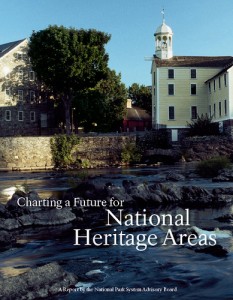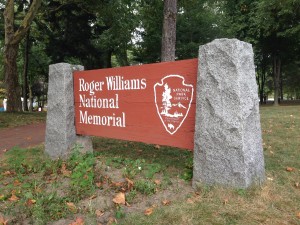Fair warning: Insider discussion coming up…

Not so long ago the Blackstone River Valley National Heritage Corridor was the pride of the National Park Service (NPS) – the poster child of the new approach to managing a living landscape. It was lauded in publication after publication and was a regular stop for visiting dignitaries looking for models of intergovernmental partnerships in action. The corridor was a prime example of the NPS extending its reach to the landscape scale using a Federal Commission that included government at every level and private citizens to care for a 550 square miles corridor spanning Massachusetts and Rhode Island and 24 communities. Non-profit and private sector partners also played a key role in corridor planning and management, whether as the stewards of key sites like museums or as co-promoters of tourism and preservation initiatives.
The story of the Blackstone Valley illustrated an arc of the nation’s industrial history stretching from sites of early industrial innovation to environmental exploitation, and then abandonment. Through its the expansive mission, the Blackstone River Valley Commission, was able to interpret the whole landscape – the connection between cities and rural areas, industrial innovation, and the regeneration of the region’s natural and cultural values.
But somewhere along the way, the NPS changed its direction in the Blackstone Valley. Perhaps it was the lingering effects of the great recession or the inborn desire to care more for resources that one owns in fee. An NPS special resource study that was originally planned to create the next level of innovation for the region’s future inexplicably rejected the continuation of the heritage commission. The study devolved into a preferred alternative that would create a traditional national park. The sweeping ideas of the original heritage corridor – partnership management of the valley – were reduced to the NPS preserving a small collection of industrial heritage sites. It certainly was not about the money as the Congressional Budget Office estimated the cost of the new park as $26 million dollars (between FY 2014-2018). The 2014 annual appropriation for the corridor program is only around $500,000. However, some argued that this was the best deal that could be crafted to keep a NPS presence in the valley. After all it was thought that a new park unit could partner with the heritage corridor and provide a stable base of operation.
Two years ago in reporting on the Blackstone situation, I noted the irony in this proposal…”Just as the NPS’s most recent strategic plan, calls for scaling up its work and promoting large landscape conservation to support healthy ecosystems and cultural resources, one of the best examples of collaborative lived-in landscape management may be headed for a down sizing.” (see full post here)
Recent congressional action on the proposed park bill for the Blackstone Valley is even more alarming than a mere down sizing. In September of 2014 the House Natural Resources Committee amended HR 706, “to establish the Blackstone River Valley National Historical Park” to strip out every reference of a partnership with the heritage corridor (along with other language that makes even establishing a traditional park problematic). This would end the innovative approach that has been in place for almost three decades.
So what is next? The Senate companion bill S. 371 still has the right stuff. But as is sometimes the case at the end of a two-year congressional session, the bills could be included in a last minute omnibus bill. If this bill rumbles down the halls of power, there will be little time to make the case for landscape scale thinking and try salvage what was once an exemplary partnership.

Another possibility is that nothing will happen. Then legislative process would have to start all over in 2015, the same year that the funding authorization for the Blackstone River Valley National Heritage Corridor ends. If that happens what will be the NPS’s role in the Blackstone Valley? Well the agency will still fly the flag over the Roger Williams National memorial a 5-acre park in downtown Providence – a long way from the landscape scale vision that once animated their work.



2 Responses
National heritage areas like Blackstone Valley are endangered because there is no long term way to fund the federal cost of the partnerships. Until that way forward is defined in something like a program bill for national heritage areas there will be more of this to come. This a political problem. Those who don’t want to see federal tax dollars spent on preserving a community’s heritage will succeed unless there is a political challenge by those who think there is value in spending tax dollars for this purpose. So far the “don’ts” are becoming more successful than the “do’s”.
Hi Tony — I am trying to understand why a program bill would assure funding. Each heritage corridor or heritage area has an Act of Congress legally authorizing funding. In what way is program legislation superior to that? Wild and Scenic Rivers System has program legislation. But the rivers managed by partners authorized by that program legislation typically get less than the typical heritage corridor or heritage area.
But I think you are right, Tony, on the point that this is a political problem and there needs to be a political challenge.
I think, but the only evidence is indirect in the Appropriations Committee report, that the Committee staff and the NPS financial staff were complicit in a deal for the NPS to draw up a list and a funding formula so to fund all the heritage “areas” as a group(there actually is no group as they each have their own legislation). This took the pressure off congress, and made the NPS chose within funds that were then limited. The funny thing was, when I checked with the NPS, they actually had no formula, despite the committee having the legal fiction that one existed. The non-fiction, hard core truth was a decision in the shadows to take the politics out of the protection of heritage resources, and cut the funding “by formula.”
There was no need to cut heritage corridor and heritage area funding for financial reasons. They are not taking funds from parks, and the funding they used at their height was a trivial part of the budget. In the 1990’s when heritage areas were picking up steam, parks got around 65 % of the NPS budget. Now, parks get around 90% of the NPS budget.
The lack of political will is the reason heritage corridors and heritage areas are being cut, not the lack of program legislation. These areas are authorized, but the Committees with the support of NPS budgeters were allowed to put the program in the shadows, and out of the sunlight of political energy and action. That is where the problem is. They already have an allocation line in both the Appropriations law and the President’s budget.